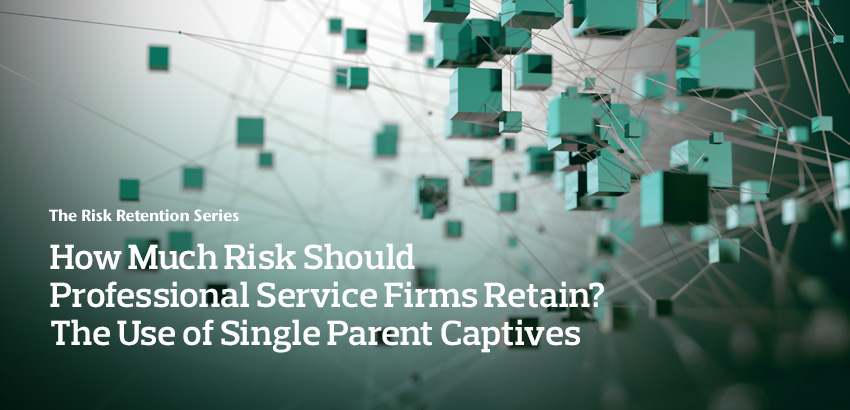Aon | Professional Services Practice
The risk retention series:
How much risk should professional service firms retain?
The use of single parent captives
Release Date: September 2021
Aon’s Professional Services Practice share insights to help firms navigate a hardening insurance market in the third article in a series exploring risk retention.
A captive insurance company exists to insure the risks of its owners. Captives are usually incorporated in jurisdictions which have specific laws about their formation and administration.
Aon’s Professional Services Practice (PSP) will be addressing three types of captives in this series of articles:
- Single parent (or pure) captives
- Group captives
- Protected cell companies
Single parent captives have a single corporate parent and write the risks of their parent owners. Occasionally, related business, such as employee risks or risks of related third parties (e.g., suppliers or customers) are also underwritten. Single parent captives have been used since at least the 1960s and have a long history with professional service firms. PSP regularly works with all three types of captives, including many single parent captives.
Over the last 18 months, PSP has seen increasing client interest in how captives enhance risk management strategies and alleviate some of the pressures of the firming insurance market, particularly in Professional Indemnity insurance.
A single parent captive can be used in a myriad of ways to solve risk issues and enhance a firm’s risk management strategy. The usage and benefits of a captive is specific to an organization and its risk objectives. However, several themes emerge from the use of captives by professional service firms:
- Captives can be used to stretch out funding of retained amounts over multiple fiscal periods, thereby smoothing the impact of higher retentions that may be imposed by insurers because of market changes and/or loss experience. Some organizations proactively choose to increase retentions and use a captive to in-fill the difference. This may be motivated by a desire to reduce premium outflow, achieve a greater degree of independence from market cycles, and/or expand policy terms and conditions.
- Many of our professional service clients have private partnership structures which have unique financial and ownership arrangements. Single parent captives can be used to address inter-generational issues in partnerships where later generations of partners may become responsible for liabilities of previous generations.
- A single parent captive can be used to share risk with underwriters using a coinsurance or quota-share structure. A quota-share arrangement is typically used on the higher priced primary layers of an insurance tower (where there is more claims frequency) with the captive writing a percentage of the risk, sharing both the premium and the losses with the commercial insurance participants. Quota-share participations can be a tangible means for an insured to signal confidence in its own risk, a positive message to send to insurers. This structure is also useful when insureds view the premium level of a layer as highly priced given the risk: quota-share lets the insured, via its captive, enjoy that premium level for its own benefit.
- In situations where upper excess layers contain gaps where the insurers cannot or will not agree to the layer pricing, captives can be used to retain risk instead of re-pricing the entire layer.
- In a successful captive, capital will build up over time with profitable underwriting years contributing to the captive’s capital base. As the capital base strengthens, the captive can increase the limits that it writes and/or the types of risks it can insure for its parent. This decreases the parent’s dependence on the insurance market and allows the captive to play a strategic role in risk management.
Single parent captives are not suitable for all organizations. But when there is a strategic fit, they can lead to a successful partnership with the efficient purchase of risk transfer coverage in the commercial insurance marketplace. A captive feasibility study can answer more detailed questions that will help determine if a captive is appropriate for your organization.
Aon’s Professional Services Practice values your feedback. If you have any comments or questions, please contact Connor Galvin.
Connor Galvin
Vice President and Director
Radnor

